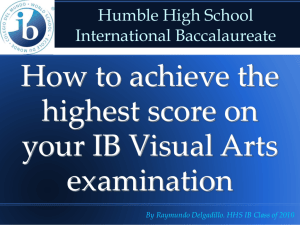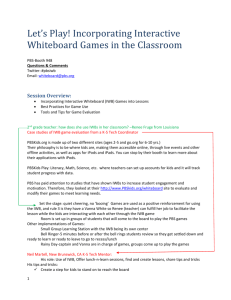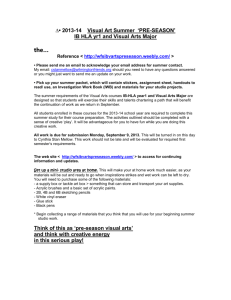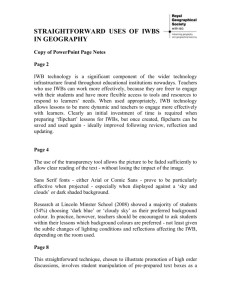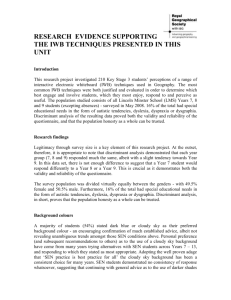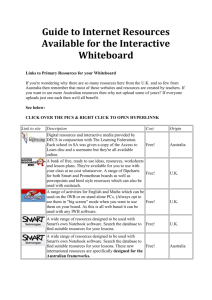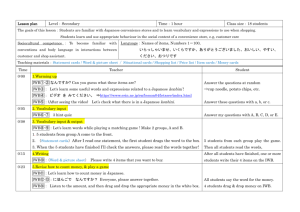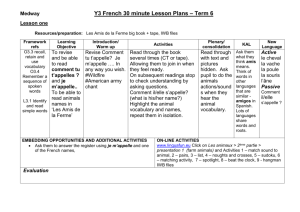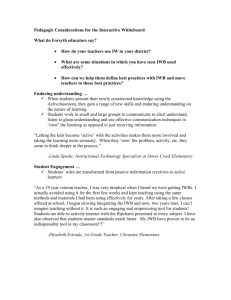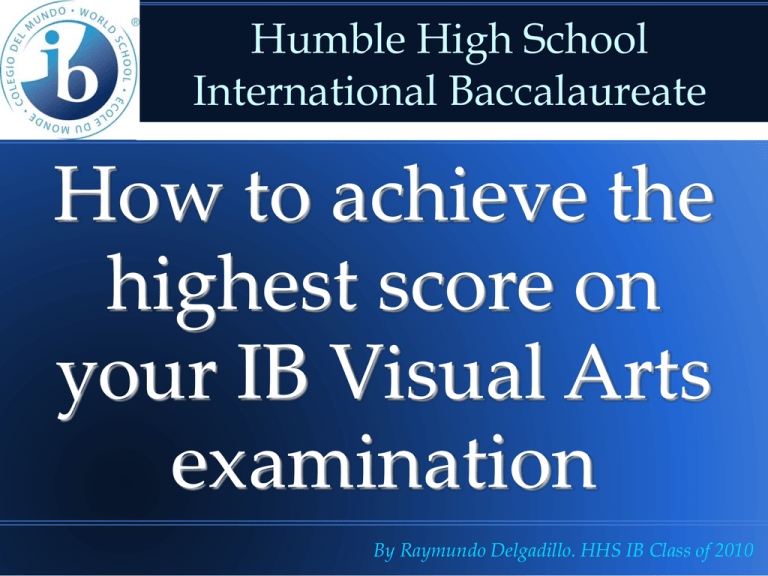
Humble High School
International Baccalaureate
How to achieve the
highest score on
your IB Visual Arts
examination
By Raymundo Delgadillo. HHS IB Class of 2010
Art is easy.... right?
INCORRECT.
Actually, according to statistics, it is one of the IB
subjects with the lowest scores...but why? I
mean, art is supposed to be easy isn't it?
Welllllll.... in short, no. A lot more work goes
into good art than you might think.
More than the skills that go into a piece, it is the
research and vision behind it that make art
fantastic in the eyes of a critic.
And by critics I don't mean your
classmates...
We mean educated adults who are
knowledgeable in the field of fine arts.
Yes,
your classmates might be a great source of
ideas, but remember, you're in IB art, you need
more than simply ideas...you need concepts,
visions, series, themes. You need to be able to
develop and transform ideas into something
much deeper, you need to be able to transform
thoughts into visuals, emotions into colors, and
actions into shapes.
That is all of course, if you want a
high grade on your exam....
If you don't....then you can just stay with ideas.
And how do I develop concepts?
Well....that is the not-so-easy part.
First you have to figure out what the focus of your
art will be. You need to come up with a theme
that ALL of your work will somehow
incorporate. Yes, I just said ALL of your work.
“Omg, how am I gonna do that?” is what you're
probably thinking, but it is actually easier than
you think. Figuring out the theme of your art is
what will take you some time.
And...what is a theme?
Well a theme is a broad idea or a message that all
of your art will convey. Notice I said “broad”.
Your theme should allow flexibility, it should
not be something restricting but simply an idea
to focus your work. The IB examiner doesn't
want to see a circus, she wants to see a Paris
fashion show. She wants something deep,
something focused, something visually
appealing.
I still don't get it.
Well you must be special.
Just kidding, it is actually not an easy concept to
grasp. So let me give you some examples of
themes:
Plants
The human body
• Dreaming
Love
Confusion
• Intimacy
Food
Animal cruelty
• Mythical figures Russian culture Pleasure
Textures
Pain
• Happiness
And how do I develop a theme?
Well, let's take one of the themes and I'll
show some concepts or art piece ideas you
can ramify from simply a word.
To make it kind of fun, I chose pleasure ;)
Money
Judgment of others
The female figure
PLEASURE
Sex
Music
Masochism
Materialism
Beauty
Chocolate
Accomplishment,
Victory
Well...that was random
I wasn't kidding when I said themes could be
broad...if you go back a slide you will notice that
all the words derived from “pleasure” are
extremely different from each other yet all of them
are united because in one way or another they
create pleasure...that is exactly what a theme
should be. It should allow you to freely explore
ideas yet unite all of your work in a way.
What does the exam consist of?
The infamous IWB...Investigation Workbook,
from which a number of pages (varies
depending on type of test) will be photocopied at
the end of the year and internally as well as
externally graded.
And
Your Studio Work...which should reflect the
number of hours spent on classroom, no
matter what medium. Art will be assessed at
the end of the year by an IB examiner.
Investigation Workbook
Chances are, you have probably heard your
classmates talk about how horrible writing
in their IWBs is...well from experience I will
tell you it isn't fun, but it is not as bad as
students make it sound. How interesting
and fun it is depends on you. Ultimately,
YOU and only you decide what goes in it,
whether research or sketches, you have the
ultimate freedom to investigate any topic. So
if doing pages on your IWB is boring, blame
yourself.
What is an IWB for?
Before you create a studio piece you must do a
little research.
That is just the way IB and the real art world
works. Most good artist don't just pick up a
paper or canvas and start drawing...for art to
have a value it has to have a purpose, and
the way you find that purpose is by doing
research and focusing your ideas on paper
before starting the piece. That is what your
IWB is for.
I don't need an IWB to focus my art
or show research...
In IB you do; and that's not up for discussion.
IB needs to see that you've put work into your
art and that you've gained knowledge in the
arts, and since there isn't an actual test in IB
Visual Arts asides from your interview with
the examiner, they need to see proof of your
exploration...all 240 hrs of it. (HL)
How do I start my IWB?
In the first few pages you should talk about
yourself and what in the field of arts
interests you. Don't go on saying “I have
brown hair & I love cookies” because IB
couldn't care less. Unless it relates arts or
what you mention somehow turns into an
art piece later, it won't get you anywhere.
For example it would be fine to have a few
pages talking about your brown hair, and
how it makes you who you are IF you plan
to do a piece about hair, otherwise, no.
Once you get started with your
art...
You should keep your IWB updated. Make
sure you throughly record at least half of
your studio pieces from start to finish. And
by that I mean:
Background research
Piece design (sketch or diagram)
Continuous updates
A picture of the finished piece
AND MOST IMPORTANTLY: Reflection
How should I write in my IWB?
A lot of people fall under the impression that their
IWB is like a diary..and it's not.
You
are not supposed to simply talk about how your
artwork is in progress, but also continuously
research things (artists, techniques, etc.) that are directly
related to your current and future artwork. You
should also practice techniques in it, but be sure
that when you do it doesn't take the whole page
and on the side you describe what you did and
how it relates to yourself and your work .
What is considered good research?
Well....in simple words, if your IWB looks like the
pages of the bible, or like a photo album...
you're not researching right.
You have to find a balance of both visuals and
writing. Do not allow either to overpower
your book, there should be equal amounts of
each. If you do a whole page of writing, make
sure you balance it by doing a whole page of
visuals that DIRECTLY relates to the writing.
But preferably it should be half and half.
Let me show you...
Unaccceptable
I like apples.
Decent
Apples are sweet, red
fruits I have always
liked.
Good
Since I was young I have
always liked apples, which are
sweet, red fruits generally
grown in Washington.
What IB is looking for
Apples are one of the most widely
cultivated tree fruits. They are
sweet and crunchy and come in
different colors.Since I was
young, I've always had a
fascination for the fruit because
my dad owned an apple
plantation. I would
Like to do a painting
showing the natural
beauty of apples,
emphasizing on the
color and shine of their skin,
Enough about the IWB...
Now let's move on to....YOUR ART!!!
I will not go into much detail on this section
because it is pretty self-explanatory. There are
only a few things IB specifically looks for.
Also, let me remind you that to be successful in IB
you DONT have to be a great artist techniquewise, it is all about deep ideas and executing
them successfully
IB likes to see progress.
IB loves to see progress. It does not matter if you
start out as the worst painter in your class,
you can still do well on your exam because
what matters to IB is how much you develop
your skills and progress as an artist. And the
way you show progress is through your IWB
and the INCREASING QUALITY in your art
work. As you practice more the quality of
your artwork will chronologically increase
and IB loves that, so do not expect your first
pieces to be Michaelangelo quality.
Your artwork should be personal
One of the IB markbands is “Artwork is directly
personal to the student” if you don't meet that
markband, you will never obtain a high score.
Personal? You might ask...Yes. Yes. Yes.
Through your IWB and interview show IB that
your artwork has a direct connection to you.
Whether your grandma died (which I sincerely
hope didn't) or you have always been interested
in painting, make sure you record the passion
behind every piece.
Artwork should chronologically
increase in depth.
And by depth I do not mean the thickness of your
canvas.
Your studio pieces should ideally be more
challenging and conceptual as time passes by.
Don't expect to get away with the same level
of challenge all year(s). That will not get you a
high score. If you want to score high, your
later pieces should not only be of deeper
meaning, but should involve more
craftsmanship. This shows your progress.
TIPS:
•
When you start researching something new,
ALWAYS make titles. Also, use your headings
to bring interest to your pages...try some cool
fonts, color letters, play with size...your goal is
to entertain the examiner...make her go
“whoa” when she goes through your book. A
simple change of color and font on your titles
will add that “whoa” and create interest.
•
Challenge yourself!
TIPS:
•
Instead of printing images from the web, go
buy yourself an art book/magazine from halfprice-books and cut out your visuals from
there...everything is already cited for you, so
all you do is cut out the picture with the
bottom citation and you're done!
•
When making a new piece, take gradual
pictures of your work on it...it's all about
progress.
TIPS:
•
Criticize yourself!!! As horrible as it sounds, it
is great to write down “I need to improve on
my painting skills, they are definitely not the
best”....it shows the examiner that you are
aware of your weaknesses and are willing to
work on them.
•
Go to art museums/galleries and record your
visits on your IWB...IB loves to see you
exploring the world of arts. I recommend the
Menil Collection...

